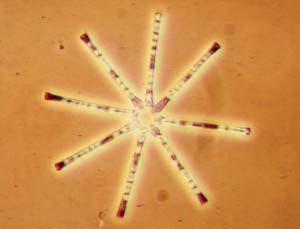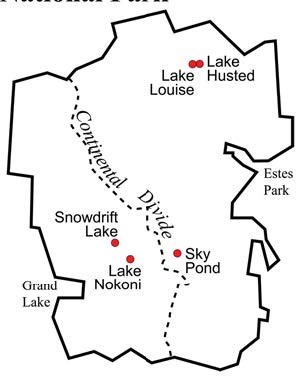Last updated: November 7, 2022
Article
Nitrogen Deposition Correlated with Changes in Lake Organisms

The Question: Is atmospheric deposition of nitrogen to park lakes changing algae communities?
The alpine lakes in the park are generally thought of as undisturbed ecosystems. There is, however, considerable evidence based on more than 20 years of study that a signifi cant amount of anthropogenic (i.e., originating from human activities) nitrogen is being deposited through rain and snow falling on the park. Sources of nitrogen include motor vehicles, power plants, factories, oil and gas wells, fertilizer, and animal feedlots. Significant emissions from all of these sources are transported in air masses from the Front Range urban corridor and other locations to the park. Past research eff orts have linked changes in the chemistry of park soils and Engelmann spruce needles to rising anthropogenic nitrogen inputs. This study investigated whether changes in diatom species and abundance occurred as a result of anthropogenic nitrogen deposition. Diatoms, a type of algae, have cell walls made from silica (just like window glass). Individual species are very sensitive to specific changes in water chemistry making them excellent indicators of water quality. They can remain in lake sediments as identifi able organisms for thousands of years. Distinctive shapes make identification relatively easy. Dr. Alex Wolfe of the University of Alberta, Edmonton, Canada, was the lead investigator.

The Project: Analyze sediment cores from five alpine lakes for diatom species presence, species abundance, and overall diatom abundance.
Scientists took cores from the deepest points in fi ve lakes: three on the east side
of the Continental Divide (Sky Pond, lakes Louise and Husted) and two on the
west (lakes Nokoni and Snowdrift). Scientists then sliced each three-foot long
core into quarter-inch increments and freeze-dried them for study and archiving.
They identifi ed and counted individual diatom species using standard laboratory
procedures. In addition scientists pulled one 12 foot-long core from Sky Pond to
document changes in diatom assemblages back to the end of the last period of
glaciation, about 14,000 before present, when diatoms were fi rst colonizing park
alpine lakes. The age of the sediments at any given depth was determined with a
dating technique that uses the activity of naturally-occurring lead isotopes (210 Pb).
The Results: Evidence strongly suggests that lake diatom assemblages have changed in response to increased nitrogen deposition.
Two diatom species that are considered indicators of nutrient rich water abruptly increased in abundance beginning around 1950. This sudden explosion of Asterionella formosa and Fragilaria crotonensis accounts for much of the sharp increase (eight-25 times pre-1950 levels) in overall diatom abundance documented in the sediment. These once rare diatoms now make up 40 percent of the total diatom community.
The rate of change in diatom assemblages since 1950, when human population growth and regional agricultural and industrial activities began to increase rapidly, is 10 times greater than what is seen in the long-term sediment record. This makes it highly unlikely that the change is due to some natural event such as changing climate or precipitation. Change in diatoms was most marked in lakes on the east side of the Continental Divide, the side most affected by anthropogenic nitrogen inputs.
